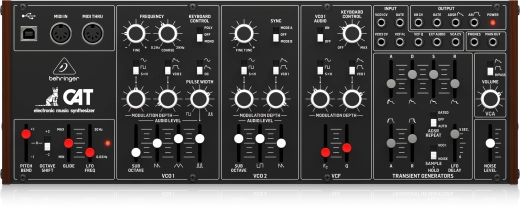Behringer CAT Legendary Duophonic Analog Synthesizer with Dual VCOs
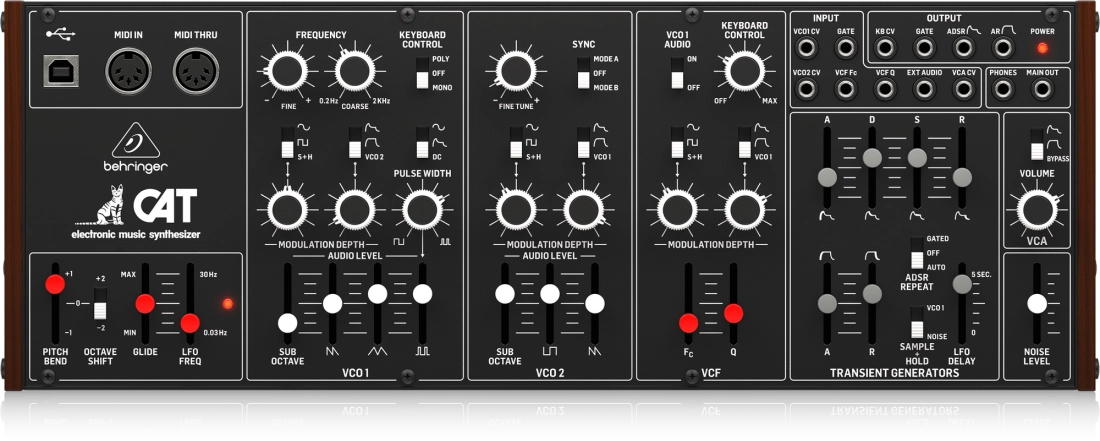
Additional Photos:
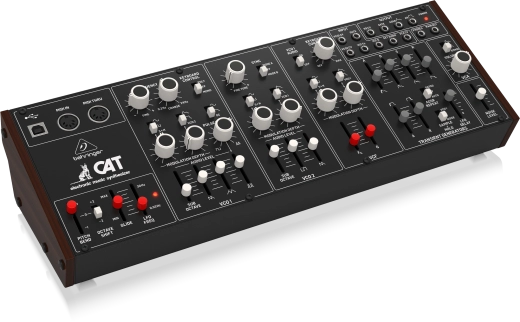
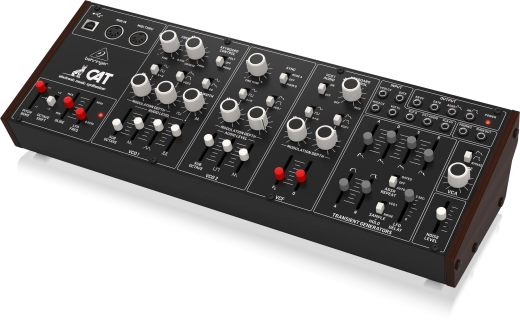
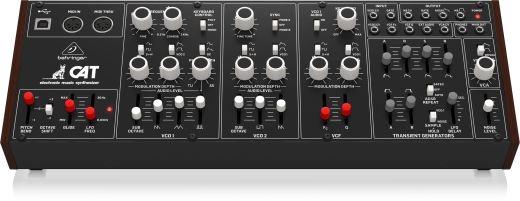

Product Videos :

In 1975, a new synth strolled into town. The Cat as it was called was an analog, duophonic, three octave synthesizer that was very similar to the ARP Odyssey. Its keyboard would produce two control voltages that were routed into its two VCOs. An ultra-affordable and even more feature-packed homage to that iconic synthesizer comes in the form of the Behringer CAT. Conjure up the virtually any sound imaginable with incredible finesse and ease. The pure analog signal path is based on authentic VCO, VCF and VCA designs in conjunction with 4 variable and simultaneous oscillator shapes and Duophonic/Paraphonic capabilities. Owning a CAT is like having your own personal time machine, enabling you to freely embrace the past or shape the future. And the best of all, it doesn't scratch.
True to the Original
Great care has been taken in engineering the CAT, including the true to the original analog circuitry, legendary VCO, VCF and VCA designs that come together to recreate classic tones that are evocative of classic electronic music. This highly-focused attention to detail is what gives the CAT its ultra-flexible sound shaping capability. It gives you the ability to cover a lot of amazing tones from super-fat bass, tasty leads and all the way to full on dreamy ambience from the far reaches of your imagination.
Big, Fat Tones
The synthesizer tracks laid down in the 1970s and 80s in progressive rock, wave and synth-pop have become classics and have inspired many other artists. The CAT lets you recreate all that magic or design some incredible and original sounds that will make you a legend in your own right!
Keyboard Control
The CAT has the ability to accept any keyboard controller via MIDI. The signals generated can be tweaked via the Pitch Bend slider which can bend a note up or down one octave. Bump this up to two octaves by flipping the Octave Shift switch up or down. Use the Glide slider to change how fast a note transitions to another; up is faster, down is slower. Combine that with the LFO Freq slider to control the LFO and ADSR repeat tempo and you can create some amazing pulsating portamentos.
Two VCOs are Better
The very heart of the CAT's sound is its two VCOs. The Duophonic/Paraphonic nature of the CAT allows both oscillators to be controlled independently. Use the Fine and Coarse Frequency controls to tune VCO1 to VCO2. Keyboard control on the CAT can be set to either Mono or Poly. Poly mode lets VCO1 generate the highest note played on the keyboard while VCO2 handles the lowest allowing two notes to be played simultaneously. Setting the switch to Mono mode makes VCO1 generate the lowest note depressed on the keyboard.
Make Waves
Waveform switches on both VCOs allow different waveforms to be patched in from the LFO. Choose between Sine, Square, Sample and Hold and even pitch modulation through each VCO. Turning the Modulation Depth knobs in either direction controls the intensity of the effect. VCO2 also comes with a Sync switch that locks VCO1 with it and has them act as one huge oscillator to produce more complex waveforms and dramatic results. Mix VCO1 into VCO2 or vice versa and the CAT can produce some really tasty tones that make themselves at home in your next synth jam.
Slide In
Each VCO on the CAT comes equipped with their own waveform sliders where you can adjust the volume of each type of VCO wave form. Pump up the Sub Octave, Sawtooth, Square, Triangle or Pulse waves or mix them all together and create some truly unique tones.
VCF
As if combining two VCOs wasn't amazing enough, the CAT comes with another set of claws in the form of a VCF filter section. Here you can get more complex and robust tones by incorporating VCO1 into the mix. Introduce more waveforms and manipulate the Q slider to emphasize harmonics and Filter Cutoff slider which acts as a low-pass filter. Turn the CAT into a really funky bass machine or an out-of-this-world synth that creates some searing lead tones. You can even create some amazing drum sounds by manipulating the VCOs, VCF and ADSR.
The Envelope, Please...
To give the signal even more character, you can use the CAT's Transient Generator to create a detailed voltage transient every time a key is depressed. Adjust the Attack, Decay, Sustain and Release via the matching sliders and to shape your signal. The AR transient generator works similarly to the ADSR but with less detailed control over the envelope. You can also set the ADSR to automatically repeat or only when a key is held down. The Sample and Hold switch can be set so the VCO1 setting is sampled or, when set to Noise mode, produce a random output pattern. Slide the LFO Delay control up or down to determine when the LFO will reach its maximum output after a key is depressed.
The Ins and Outs
The CAT features a whole slew of Inputs and Outputs that expand its capabilities beyond what you can see out of the box. You can route external control voltages to VCO1 or 2, the VCF and even pump in some external line-level audio into the CAT. You can even connect the CAT to other external synthesizers through the Gate, ADSR, AR or Keyboard Outputs. The CAT's 16-note Poly Chain function lets you combine multiple synthesizers for up to 16-voice polyphony and it provides vastly improved reliability and stability over its 1970s and '80s predecessors.
Controls & Connectivity
Behringer just can't help themselves like you, they're gear-heads, too. For those who want the numbers, the CAT has 47 controls, all laid out in a highly-intuitive format that puts the joy back into your music creation.
Unleash Your Imagination
When it comes to not just pushing envelopes but creating them, the CAT gives your imagination its voice and it's so very affordable. When modern performance calls for classic analog sound it calls for the Behringer CAT!
Features
• Amazing analog synthesizer with dual VCO design allows for insanely fat music creation• Authentic reproduction of original "CAT SRM II" circuitry with matched transistors and JFETs
• Pure analog signal path based on authentic VCO, VCF and VCA designs
• 4 variable and simultaneous oscillator shapes (Sawtooth, Triangle, modulated Pulse and Sub-Octave Square) for ultimate sounds
• Duophonic/Paraphonic mode allows both oscillators to be independently controlled
• Oscillators can be modulated from 6 different sources with 2 modulation depth attenuators
• Classic filter design (low pass with peak/resonance) with self-resonance capability
• Filter can be modulated from 6 different sources with 2 modulation depth attenuators
• Dedicated and fully analog sine/square wave LFO
• 2 analog Envelope Generators for modulation of VCF and VCA
• White noise generator dramatically expands waveform generation
• 16-voice Poly Chain allows combining multiple synthesizers for up to 16 voice polyphony
• Complete Eurorack solution main module can be transferred to a standard Eurorack case
• 47 controls give you direct and real-time access to all important parameters
• Audio input for processing external sound sources for enhanced creativity
• External control inputs and outputs (High Note CV, Low Note CV, Gate, Filter etc.)
• Comprehensive USB/MIDI implementation with MIDI channel and Voice Priority selection
Media
Q & A
Reviews

Protect your investment with the Long & McQuade Performance Warranty
A warranty can be a very important factor when making a buying decision. Because repairs can be very expensive in terms of parts and labour costs, manufacturers usually only provide one year limited warranties that generally only cover items that malfunction due to a manufacturer’s defect. With an important purchase such as a musical
instrument or piece of studio gear, however, many people want to have the peace of mind in knowing that their investment will be protected should the product no longer be performing at 100%.
Because of this, Long & McQuade provides our customers with a FREE one-year Performance Warranty on most of our products. The Long & McQuade Performance Warranty supplements the manufacturer’s warranty to ensure that our customers receive complete “no hassle” warranty coverage within their first year.
How does the Long & McQuade Performance Warranty differ from most manufacturers' warranties?
- Performance Guarantee: Normal wear and tear is covered, so your product will be performing as well as the day you purchased it for the entire duration of the coverage. Band and Orchestral Performance Warranty does not include replacing pads or cleaning for woodwind instruments, unless deemed necessary by our repair staff. Ultrasonic cleaning for brass instruments will be provided if deemed necessary by our repair staff, but is not routinely offered under the Performance Warranty.
- Product Replacement: If your product cannot be fixed or costs too much to fix, we will replace it with the equivalent model for no additional charge. If this is not possible, a full refund will be provided.
- No Lemon Policy: Your product will be replaced should the same problem occur multiple times.
- Convenient: Easy drop off and pick up of the product at any Long & McQuade location.
- Guitar Setup: Guitars purchased at Long & McQuade come with 1 free setup, to be redeemed within 1 year for new guitars and 90 days for used guitars.
- Loaners Available: A loaner product may be given while the product is being repaired.
- Power Surge Protection: Your product is covered even if damaged from a power surge.
- Accessory Coverage: Any peripheral devices or accessories that come with your product (i.e. foot pedal, case) are also covered.
- Commercial Use Coverage: Music and recording professionals who purchase gear for “heavy-use” commercial purposes will still be covered.
Long & McQuade reserves the right to restrict the purchase of additional years of Performance Warranty. Used products come with a 3-month Long & McQuade Performance Warranty. Some products (i.e. computers, software, cymbals and other items) are covered only by the manufacturer‘s warranty. Consumables (i.e. strings, reeds, drum sticks, batteries, tubes, cross faders) are excluded as they are designed to be replaced. Cosmetic Damage, Accidental Damage, or problems caused by Humidity or Temperature Issues are not covered. Speakers damaged by overpowering are generally not covered. Our coverage does not provide compensation for loss of use. As of June 2018 the Performance Warranty is no longer transferable. The warranty is only valid in Canada.
Purchasing additional years of coverage
Some manufacturers provide warranties for longer than 1 year; however, these are usually limited warranties that do not provide the same coverage as the Long & McQuade Performance Warranty. Customers interested in more complete and convenient (but not necessarily longer) coverage are still able to purchase additional years of the Performance Warranty.
If you are interested in receiving this coverage for longer than one year, you have the option of purchasing additional years of the Performance Warranty. The pricing is as follows:
- NEW products: Starting at 4% of the current new selling price to double the warranty from 1 year to 2 years. Starting at 4% for each additional year.
- USED products: Starting at 4% of the current new selling price to increase the warranty from 3 months to 1 year. Starting at 4% for each additional year.
- GUITARS: 4% of the current new selling price to double the warranty from 1 year to 2 years. 4% for each additional year. $45 maximum. An additional free setup is not included with additional purchased years of Performance Warranty.
- BAND and ORCHESTRAL instruments: 4% of the current new selling price to double the warranty from 1 year to 2 years. 4% for each additional year.




